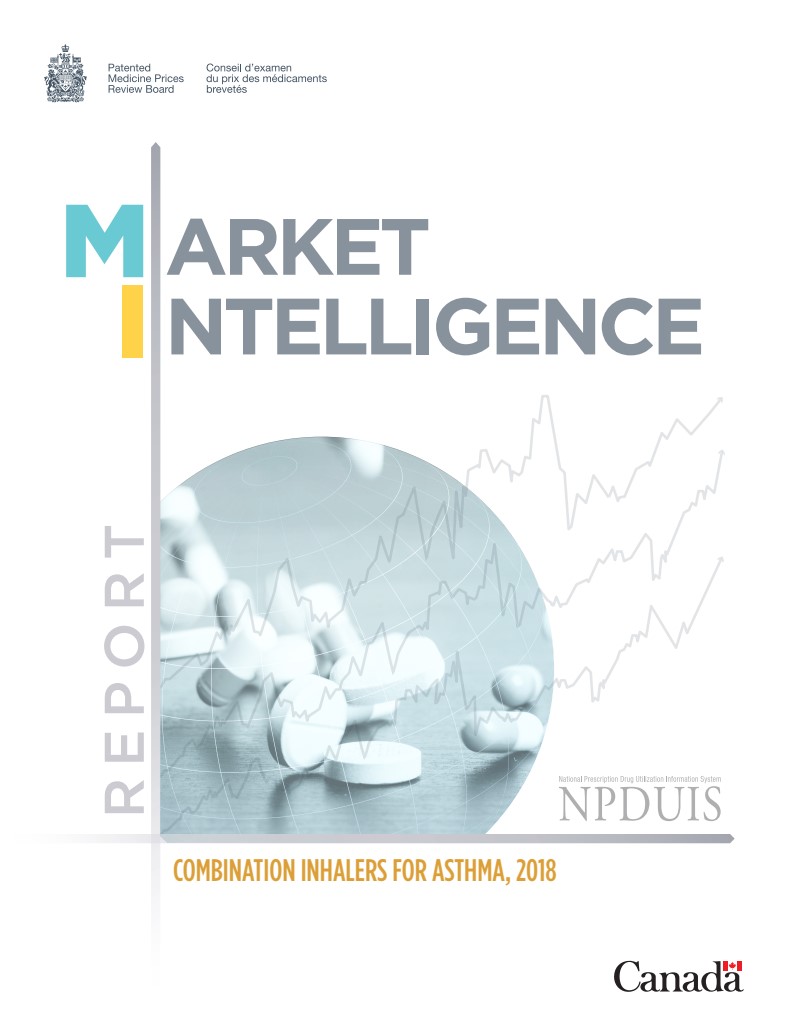Market Intelligence Report: Combination Inhalers for Asthma, 2018
The PMPRB Market Intelligence Report series provides detailed information on specific therapeutic market segments of importance to Canadians. These targeted analyses are designed to inform policy discussions, aid in evidence-based decision making, and provide Canadians with insight into issues pertaining to pharmaceutical pricing and utilization in Canada and internationally.
This edition of the report analyzes the market for inhaled corticosteroid (ICS) and long-acting beta agonist (LABA) combination inhalers used in the treatment of asthma. These medicines generate annual sales of over half a billion dollars in Canada and represent close to half of the total sales for obstructive airway disease medicines. Canadian list prices for combination inhalers for asthma far exceed the levels prevailing in many other countries, and in fact, this sub-class tops the list of therapeutic areas with the greatest cost implications due to higher prices in Canada.
Asthma is the most common chronic respiratory disease in Canada, affecting over three million Canadians and imposing substantial costs in terms of drug spending as well as lost productivity. This report examines four combination inhalers available in Canada that are used to maintain control over asthma symptoms as part of a continuum of treatment:
- Advair (fluticasone/salmeterol): launched in 1999
- Symbicort (budesonide/formoterol): launched in 2002
- Zenhale (mometasone/formoterol): launched in 2011
- Breo Ellipta (fluticasone/vilanterol): launched in 2013
The analysis provides insight into the use of these medicines, as well as their market shares, pricing, and annual treatment costs. It explores Canadian markets from the national as well as public and private payer perspectives, positioning them within an international context. The findings are centred on the 2018 calendar year, with a retrospective look at trends in recent years.
International markets examined include the Organisation for Economic Co-operation and Development (OECD) members, with a focus on the seven countries the PMPRB currently considers in reviewing the prices of patented medicines (PMPRB7): France, Germany, Italy, Sweden, Switzerland, the United Kingdom (UK), and the United States (US).
The results of this study will inform policy discussions and aid in evidence-based decision making on the price and reimbursement of these medicines at the public and private payer levels in Canada.
Key Findings

Canadian per capita sales of combination inhalers for asthma are among the highest in the OECD
- In 2018, sales of combination inhalers for asthma in Canada totalled $577 million, accounting for 2.3% of the total pharmaceutical market, the fifth highest share in the OECD and well above the median of 1.2%.
- Canadian per capita sales for combination inhalers for asthma were more than double the OECD median in 2018, placing Canada second among the OECD countries, while per capita consumption ranked 10th.

Combination inhalers for asthma have not benefitted from the same level of generic competition as oral solid medicines
- In Canada, the first competitor inhaler delivering the same combination of medicines as Advair was approved in 2018; two other same-combination competitors were approved in 2019 and 2020, including the first generic version of Advair. None of these medicines had recorded sales data at the time of analysis.
- Same-combination competitors of Advair and Symbicort were approved much earlier in all of the PMPRB7 comparator countries, except Switzerland, although their uptake has been relatively low.
- Prices discounts for same-combination competitors varied across the PMPRB7: while European countries offered prices up to 29% lower than the top-selling strengths of the originator brands in Canada in 2018, in the US the discounts for a newly-launched generic were deeper, at up to 66% less than the originator brand price.

Despite relatively modest per patient treatment costs, the widespread use of combination inhalers for asthma makes them a strong contributor to Canadian drug plan spending
- In 2018, combination inhalers for asthma made up 2.7% of the total drug costs for Canadian public plans and 2.3% of private drug plan costs.
- Canadian public drug plans, which provide coverage to specific population groups including seniors, reimbursed slightly over half of all retail sales of combination inhalers for asthma in 2018, with 5.2% of the beneficiaries being treated with at least one of these medicines.
- The average annual drug costs per patient were between 31% and 53% higher for each combination inhaler in public plans than in private plans, mainly due to a higher rate of consumption by the beneficiary population in the public plans.

When comparing brand prices for combination inhalers in Canada to foreign markets, Canadian prices are consistently higher, with important cost implications for both public and private payers
- Canadian average list prices for combination inhalers for asthma were the second highest among the PMPRB7 in Q4-2018, trailing only the US, and are substantially higher than the OECD median.
- Compared to Canadian levels, median PMPRB7 prices were 59% lower for Advair, 36% lower for Symbicort, and 54% lower for Breo Ellipta in Q4-2018.
- Compared to the OECD countries, the differentials between Canadian and foreign prices were even greater, with median OECD average prices 64% lower for Advair, 50% lower for Symbicort, and 56% lower for Breo Ellipta.
- The cost implications of paying higher prices for combination inhalers for asthma in Canada are substantial, estimated at $264 million nationally in 2018 when compared to median PMPRB7 levels.
